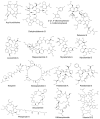Symbioses of Cyanobacteria in Marine Environments: Ecological Insights and Biotechnological Perspectives
- PMID: 33923826
- PMCID: PMC8074062
- DOI: 10.3390/md19040227
Symbioses of Cyanobacteria in Marine Environments: Ecological Insights and Biotechnological Perspectives
Abstract
Cyanobacteria are a diversified phylum of nitrogen-fixing, photo-oxygenic bacteria able to colonize a wide array of environments. In addition to their fundamental role as diazotrophs, they produce a plethora of bioactive molecules, often as secondary metabolites, exhibiting various biological and ecological functions to be further investigated. Among all the identified species, cyanobacteria are capable to embrace symbiotic relationships in marine environments with organisms such as protozoans, macroalgae, seagrasses, and sponges, up to ascidians and other invertebrates. These symbioses have been demonstrated to dramatically change the cyanobacteria physiology, inducing the production of usually unexpressed bioactive molecules. Indeed, metabolic changes in cyanobacteria engaged in a symbiotic relationship are triggered by an exchange of infochemicals and activate silenced pathways. Drug discovery studies demonstrated that those molecules have interesting biotechnological perspectives. In this review, we explore the cyanobacterial symbioses in marine environments, considering them not only as diazotrophs but taking into consideration exchanges of infochemicals as well and emphasizing both the chemical ecology of relationship and the candidate biotechnological value for pharmaceutical and nutraceutical applications.
Keywords: animal interactions; bioactive molecules; cyanobionts; diazotroph; infochemicals; prokaryotes; secondary metabolites.
Conflict of interest statement
The authors declare no conflict of interest.
Figures




References
-
- Leung T.L.F., Poulin R. Parasitism, commensalism, and mutualism: Exploring the many shades of symbioses. Vie Milieu. 2008;58:107–115.
-
- Lee Y.K., Lee J.H., Lee H.K. Microbial symbiosis in marine sponges. J. Microbiol. 2001;39:254–264.
Publication types
MeSH terms
Substances
LinkOut - more resources
Full Text Sources
Other Literature Sources
Medical

